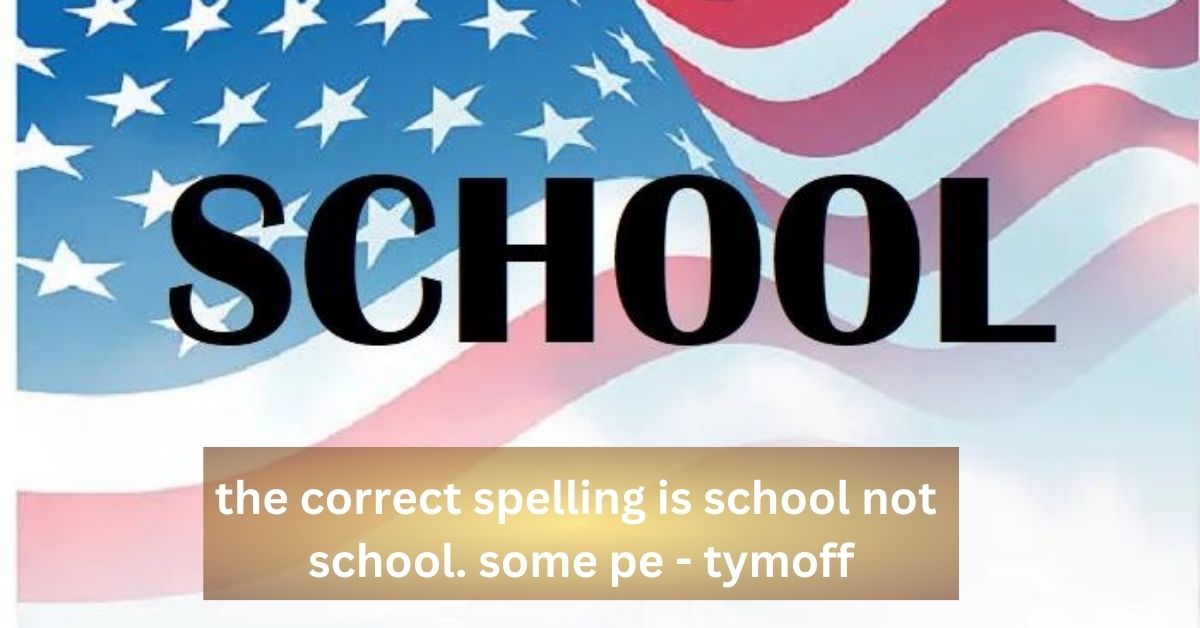In a world driven by communication, the correct spelling of words holds immense importance, especially in educational settings.
Use “school” instead of common misspellings like “school,” “school,” or “school.” Ensure accurate communication by sticking to the correct spelling.
In This Article, we discuss the main topics.
The Power of Language: Why Correct Spelling Matters
In the vast language landscape, correct spelling emerges as a cornerstone, wielding a profound influence on effective communication and academic prowess.
The power of language is intricately tied to the accuracy of its spelling, serving as the linchpin for conveying thoughts with clarity and precision.
In educational settings, mastering correct spelling transcends the mere arrangement of letters; it becomes a catalyst for building confidence in writing and strengthening overall communication skills.
Furthermore, the significance of accurate spelling extends beyond the classroom, permeating professional and real-world scenarios.
The power of language, embodied in incorrect spelling, is the key to unlocking a world of practical expression and academic success.
1. Enhancing Communication Skills
Good spelling is the foundation of effective communication. Students who grasp the nuances of spelling are better equipped to express themselves clearly, fostering strong communication skills that extend beyond the classroom.
2. Building Confidence in Writing
Accurate spelling contributes to proficient writing. As students master spelling, they gain confidence in expressing their thoughts through the written word. This confidence serves them well in academic and real-world scenarios.
3. Strengthening Academic Performance
Correct spelling is closely tied to academic success. In examinations and assignments, spelling errors can impact grades. Understanding the importance of spelling enhances students’ academic performance.
Common Spelling Misconceptions Debunked
In the realm of language, dispelling common spelling misconceptions is a crucial journey toward linguistic clarity. One prevalent myth involves the ‘I before E’ rule, where we explore exceptions, preventing students from succumbing to oversimplified guidelines.
Another pitfall lies in silent letters, a linguistic maze unveiled to help students navigate the complexities of silent consonants and vowels.
Homophones, those tricky words that sound alike but differ in spelling, are another hurdle we tackle, ensuring a clear understanding to avoid common pitfalls.
By debunking these misconceptions, learners gain a solid foundation, fostering a more accurate and confident approach to spelling.
1. The ‘I before E’ Conundrum
Unravelling the myth of ‘I before E except after C.,’ We explore instances where this rule doesn’t apply, preventing students from falling into the trap of oversimplified spelling rules.
2. Silent Letters: Navigating the Quiet Quirks
A deep dive into words with silent letters, debunking the confusion surrounding their usage and helping students decipher the intricacies of silent consonants and vowels.
3. Homophones: Words that Sound Alike but Spell Differently
An exploration of homophones and how mastering them can prevent common spelling mistakes. From ‘their’ and ‘there’ to ‘your’ and ‘you’re,’ we demystify these linguistic challenges.
The Digital Age: Spelling Challenges in the Online Realm
In the ever-evolving landscape of the Digital Age, spelling faces unique challenges in the online realm. The prevalence of autocorrect, while a blessing in rectifying errors, poses the risk of dependency, potentially hindering active engagement with spelling challenges.
Additionally, the rise of texting language blurs the lines between casual communication and the need for precision in formal settings.
We explore how these digital dynamics impact spelling skills, emphasizing the importance of balancing technological aids with a conscious effort to retain and enhance traditional spelling abilities.
Navigating these challenges ensures that students develop robust spelling competencies that fit the demands of the modern, tech-driven world.
1. Autocorrect Dependency: Blessing or Curse?
They are analyzing the impact of autocorrect on spelling skills. While it aids in fixing errors, overreliance on autocorrect can hinder students from actively engaging with their spelling challenges.
2. The Rise of Texting Language
We are investigating the influence of texting language on formal spelling. We address concerns about the blurring lines between casual texting and the necessity for precision in educational and professional settings.
Empowering Educators: Strategies for Effective Spelling Instruction
Empowering educators with practical strategies for spelling instruction is pivotal in shaping students’ language proficiency. Integrating spelling into daily lessons is fundamental, embedding it seamlessly within various subjects to reinforce its importance.
Embracing technology emerges as a powerful ally, with innovative tools and apps making spelling lessons engaging and interactive.
Recognizing diverse learning styles is another crucial aspect, as are tailoring methods for visual and auditory learners and ensuring inclusivity in the educational process.
By providing practical guidance to educators, we aim to equip them with the tools necessary to instil a robust foundation in spelling, contributing to students’ overall language development and academic success.
1. Integrating Spelling into Daily Lessons
We highlight the importance of making spelling an integral part of everyday lessons—practical tips for educators on seamlessly incorporating spelling exercises into various subjects.
2. Utilizing Technology for Interactive Learning
Exploring innovative tools and apps that make learning spelling engaging and interactive. Embracing technology to enhance spelling skills in a way that resonates with tech-savvy students.
The Psychology of Spelling: Understanding Learning Styles
Delving into the psychology of spelling unveils a nuanced understanding of diverse learning styles. Acknowledging that not all students absorb information similarly, we explore tailored approaches for visual and auditory learners.
Educators can create a more inclusive and effective spelling curriculum by recognising and accommodating these distinct learning preferences.
Additionally, we delve into mnemonics, offering creative memory aids to enhance spelling mastery.
Understanding the psychology behind how students grasp and retain spelling concepts allows for a personalized and engaging educational experience, fostering a deeper connection with language and facilitating more comprehensive spelling proficiency.
1. Visual Learners vs. Auditory Learners: Tailoring Instruction Methods
They are acknowledging that not all students learn the same way. We discuss strategies to cater to visual and auditory learners, ensuring that spelling lessons resonate with diverse learning styles.
2. Mnemonics: Memory Aids for Spelling Mastery
They were unveiling mnemonic devices as practical tools for memorizing complex spellings. How educators can use these creative memory aids to make spelling lessons memorable for students.
FAQs
1: Is there an ideal age to start teaching spelling?
While it varies for each child, introducing spelling concepts early in their education lays a strong foundation for future learning.
2: How can parents support their child’s spelling development?
Encourage reading, engage in spelling games, and create a positive environment that fosters a love for language.
3: Are spelling bees still relevant in the digital age?
Absolutely! Spelling bees promote healthy competition, boost confidence, and make learning fun for students.
4: Can technology hinder spelling skills?
While technology can be a valuable tool, overreliance on autocorrect without actively engaging with spelling can have negative consequences.
5: How can educators make spelling lessons more engaging?
Incorporate interactive activities, use technology, and personalize lessons to cater to different learning styles.
Conclusion
In conclusion, opt for the correct spelling, “school,” and avoid common misspellings such as “school,” “school,” or “school.” Prioritizing accuracy in your written communication enhances clarity and practical expression.



